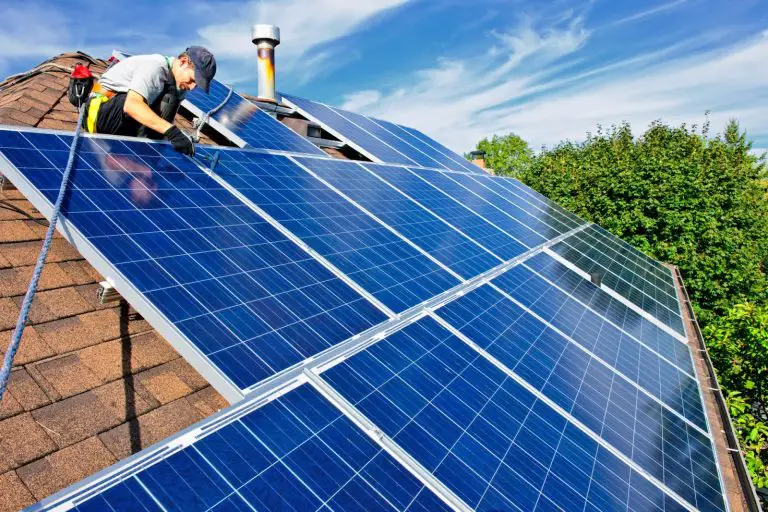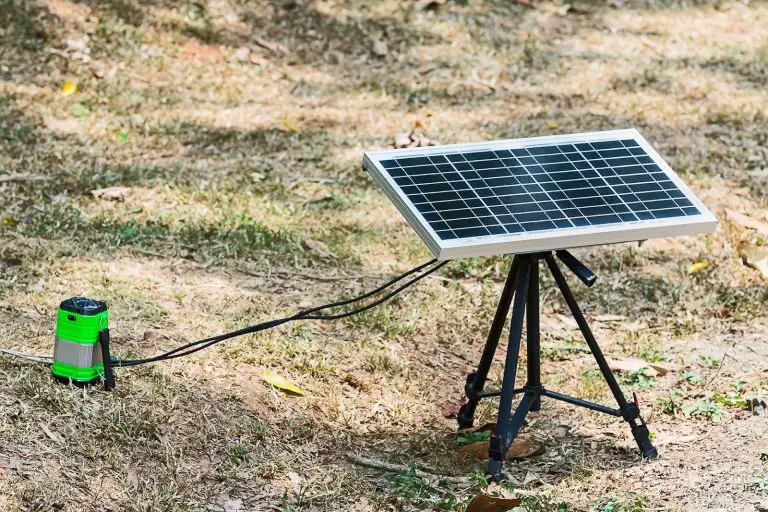Do Solar Panels Drain Batteries at Night?
The way solar panels work is by generating electricity from the sun’s rays throughout the day while the sun is shining and storing that power in a battery bank from where it can be used to power homes, appliances, and devices. During the night, the solar panel system regulates the charging and discharging of the batteries by employing reverse current.
Solar panels can minimally drain the batteries’ stored energy at night if no charge controller has been installed. The charge controller is the feature of any solar panel system most important for preventing complete battery discharge during the night. They also prevent batteries from overcharging.
I’ll take a closer look at how charge controllers work, what happens at night when the batteries reach their capacity, as well as how to select the correct batteries and size them properly for the system you have installed.
What Happens at Night
Solar panels generate power from sun rays, which means that they cannot generate power during the night. However, it’s still possible to use the solar batteries’ stored power throughout the hours that no sunlight is present.
This is where your charge controller comes in. Most solar panel systems will have a built-in charge controller, and it is one of the most important aspects that regulate battery charging.
The charge controller ensures that the batteries remain full and that they don’t overcharge or discharge completely, as both situations can decrease the battery’s lifespan.
During the night, when the battery is usually fully charged, the charge controller will reverse the incoming power, pushing it back into the solar panels or the grid, depending on the system in question.
Although this prevents the potentially dangerous situation of overcharging solar batteries, it can mean that some of the generated power is lost.
However, this is where the charge controller comes into play again, as it will stop the reverse current should the battery reach a certain state of discharge.
The Most Popular Batteries for Solar Arrays
Solar energy has seen a significant increase in both popularity and use, and it is used in a wider variety of applications as it is developed and improved. Improvements in both the panels and other features such as the battery type have made solar energy much more efficient than it used to be.
Deep-Cycle Batteries
Deep-cycle batteries are often used in solar panel systems as they handle both charging and discharging very well. A deep-cycle battery can handle being heavily discharged using the majority of its capacity, and it is usually a term associated with lead-acid batteries.
The battery types used in solar panel systems must keep up with the demands of unstable grid energy, irregular charging to capacity, and what can be termed “heavy cycling,” which is the continuous charging and discharging of the battery in question.
This means that they are well-suited to solar panel arrays as they can easily handle a discharge during the night when the solar panels cannot produce power. Should you opt for a different type of battery, the battery’s lifespan might be impacted if discharged continuously throughout the evening hours.
One of the most frequently used batteries for solar panel applications is deep-cycle, lead-acid batteries. These batteries are often used where renewable energy is concerned; as they are reliable and cost-efficient, they are the preferred batteries for use, particularly where off-grid applications are prevalent (source).
AGM Batteries
AGM is an acronym for an absorbent glass mat battery. AGM batteries usually have very low internal resistance, can easily deliver high currents on demand, and generally have a fairly long lifespan, even when they are run in a deep-cycle configuration.
The benefits of AGM batteries are that they are maintenance-free, very reliable, and conveniently lighter than the flooded lead-acid batteries. Where it concerns solar panel arrays, AGM batteries can withstand more heat and will discharge at a much slower pace compared to other types of batteries.
It is important to note that although AGM batteries are popular for smaller solar arrays, they cannot always handle that much input, so it would work better for camping situations or other outdoor activities where power is necessary and where you would use a smaller solar panel configuration.
AGM batteries are a popular choice for solar panel systems because they are less hazardous than some other types of batteries, making them perfect for DIY solutions. As they are lightweight and resistant to cold temperatures, they are usually preferred for smaller off-grid systems where they will be exposed to the elements (source).
Correctly Sizing Solar Batteries
Although some types of batteries are better suited to solar panel arrays than others, the most important factor when choosing batteries for your solar panel system is selecting the correct size.
The best way to go about it is to make sure that the full battery bank of the system is big enough so that it can easily manage the electrical load generated by the solar panels while still generating enough power for either your home or off-grid system without discharging the batteries completely or to a point where they may suffer damage.
It is possible to wire together several batteries in order to design a battery bank that’s well-suited to your solar panel array and your power needs. There are a number of factors to take into account when designing your battery bank.
The first and most obvious factor is understanding how much power you need to generate to adequately fuel your devices and appliances. It is also essential to consider the number of days you’ll need the batteries to last before they need to be charged again. If you need them to perform for a few days at a time, you’ll need several batteries that can manage a larger load.
However, the most significant thing to consider is the amount of volts your solar panel array can produce. If the system can produce 48 volts, your batteries will need to have the capacity to store this.
It is smarter to opt for a battery bank with a little less voltage capacity than your system can produce, so for a 36-volt system, you’ll want a 24-volt battery bank. The reason for this is to ensure the battery can still be fully charged even if there is a drop in the voltage coming from the panels.
If you are installing the system yourself, consider your panels’ voltage and factor in a 2–3% voltage drop for your battery bank. So, for a 16–18-volt system, a 12-volt battery bank will be sufficient.
The final important item on your consideration list when sizing batteries is to take into account the storage capacity that you need the battery to have. This is particularly important if you don’t want your batteries drained throughout the night.
If you don’t have that many sunlight hours during the day, you’ll need more batteries to last out the night. This storage capacity of a battery is called the amp-hours. The more amp-hours you have, the longer your battery will take to drain (source).
The Rate of Discharge
A battery’s rate of discharge is actually displayed on the battery itself. The slower your batteries discharge, the more usable power hours you’ll get out of them. The way you can determine a specific battery’s discharge rate is to look for the value marked C-?. The question mark here is a placeholder for a number of hours.
This means that if this value is noted as C-10, that means that it will take 10 hours to fully discharge that battery, and if it is noted as C-5, it will take five hours to drain the battery. If you want your batteries to last longer, selecting a longer rate of discharge is preferable.
Most batteries, including lead-acid batteries, will start to degrade as they are run through continuous charging and discharging cycles. This degradation will slowly reduce their ability to store power, which, in turn, affects the operational lifespan of the battery.
It is not good to discharge a lead-acid 100% each time it is used, as this will significantly shorten its lifespan to if it were only discharged to a maximum of 50%, for instance. That is why it is so important to consider the rate of discharge.
Final Thoughts
Solar panels have been designed in such a way as to make the most efficient use of the power they generate from the sun. Although solar panels can minimally drain batteries at night to prevent battery overcharging, this should never become a problem as the batteries will never discharge fully, thanks to the charge controller’s role.
Additionally, by taking into account the rate of discharge of the battery in question, as well as correctly sizing solar batteries for the panels you have and the devices and appliances you need to power, you can prevent discharging your batteries during times when the panels cannot produce power, such as at night or on cloudy days.






